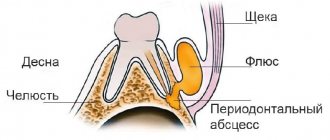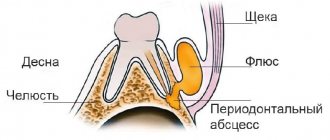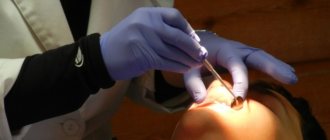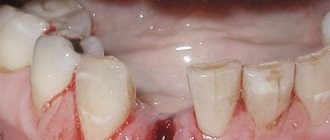Reasons for installing a crown
A crown is a kind of cap that is placed on a tooth, covering and protecting its tissue. Installed in three cases:
- If the natural crown of the tooth is destroyed by more than half and it is impossible to restore it with filling material or other restoration methods;
- To improve the aesthetics of the dentition - correct the shape of the tooth, hide visual flaws;
- When using prosthetics using a bridge. In this case, crowns are placed on the supporting teeth.
A crown can only be installed on a tooth with an intact root. If the upper part is significantly destroyed and the carious process has reached the pulp, before installing the crown, the tooth is depulped and the root canals are filled.
When installing a bridge, the supporting teeth are covered with dental crowns, even if they are not destroyed. If the tooth is relatively healthy, the dentin and pulp are not affected, crowns can be installed without depulpation.
Our clinic’s specialists do not recommend that patients install bridges, but offer alternative types of prosthetics if the supporting teeth are healthy. To place a crown, the doctor must prepare (grind) the tooth, that is, completely remove the enamel. Without a natural protective layer, even if covered with a crown, the tooth becomes vulnerable and gradually collapses. A bridge should only be placed on teeth that have “nothing to lose.”
How long will it take to get used to
It is almost impossible to answer this question - the time required to get used to the prosthesis is strictly individual and can vary from several hours to weeks or more. There are even cases when the patient had to completely abandon the use of a prosthesis, the process of getting used to it was too difficult and long.
It can be noted that it takes less time to get used to fixed dentures on pins or crowns installed on the tooth stump.
It is somewhat more difficult, but also usually without any particular difficulties, to get used to dental bridges.
The method of their attachment and the distribution of loads during chewing is most natural and almost completely corresponds to the similar parameters of natural teeth. Also, there are no additional foreign elements in the oral cavity - fixing hooks and staples.
On the contrary, getting used to removable dentures can be complicated by additional factors. Thus, in clasp dentures, chewing loads are distributed through a system of arches and brackets onto the palate and adjacent teeth. Unnatural sensations when chewing cause irritation and make it difficult to get used to the clasp denture.
In any case, chewing should not cause severe pain at the site of the prosthesis. If you experience pain when chewing, especially severe pain, consult a doctor immediately.
Materials for making crowns
Modern dental crowns are made from:
- Metal.
Metal dentures are considered obsolete due to their lack of aesthetics, but are still used because they are the cheapest option; - Metal ceramics.
A relatively inexpensive and durable option, but due to the metal base it is difficult to achieve a “healthy” whiteness of an artificial tooth; - Ceramics.
Ceramic crowns are more aesthetically pleasing than metal-ceramics, but are inferior in strength, so they are usually installed only on the front teeth; - Porcelain.
A type of ceramic crown. Porcelain dentures are indistinguishable from living teeth, since the optical properties of the material are almost identical to tooth enamel. They are also installed on the front teeth; - Zirconia.
They are made on the basis of zirconium dioxide and covered with ceramics on top. Durable, aesthetic, but quite expensive crowns.
Zirconium dentures can be installed on any tooth.
The material, contrary to popular belief, does not cause toothache, but may be the answer to the question of why the gums hurt after installing a crown. Inflammation of the mucous membrane and gums can cause an allergic reaction to the metal in a metal-containing crown. Patients with ceramic and zirconium prostheses do not encounter such problems.
What is a metal-ceramic bridge?
A dental bridge made of metal-ceramics is a non-removable permanent prosthesis consisting of several metal-ceramic crowns, combined with each other at the manufacturing stage. Intermediate crowns (solid) replace missing teeth, and extreme crowns (hollow inside) are placed on supports (living teeth or their roots, on implants). The base or frame of the bridge consists of a metal alloy - with cobalt, nickel, chromium, less often with titanium or with precious metals (platinum, gold, palladium, silver). On top of the metal is lined with porcelain - a ceramic mass with a hint of natural enamel. You can see in the photo how your smile changes before and after the installation of this orthopedic structure.
Why can a tooth hurt under a crown?
Toothache can occur for several reasons, most of which are associated with poor preparation of the tooth for the installation of a crown. First of all, these are errors when filling root canals after depulpation.
Causes of inflammation
Inflammation under the crown can cause:
- Insufficient filling of canals. If the canal is not filled with filling material to the top, the empty space is quickly populated by pathogenic microflora. Its waste products cause inflammation.
- Poor obturation (filling of canals). If the doctor was in a hurry or, due to inexperience, did not fill the canals tightly with filling material, bacteria will settle in the resulting pores, which will ultimately cause inflammation. Crown pain may occur months or years later.
- Perforation of the canal wall. Most often this happens when the doctor mechanically expands a canal with an uneven axis with a rasp. For example, in a curved or bent root. In order to properly seal the canals in such roots without breaking through the wall, a specialist needs extensive practical experience. The doctor may also damage the wall when installing the pin. If the hole is immediately closed with a special material, there will be no complications. But if the doctor simply fills the canal without closing the “gap,” problems may arise. The filling material is not completely biocompatible with the periodontium - the connective tissue surrounding the root. If, through the resulting hole, it extends beyond the canal, the periodontium becomes inflamed. A complication of the inflammatory process can be a cyst or granuloma.
- A fragment of an instrument in the canal cavity. Unfortunately, this is a common occurrence. The instrument may break due to improper use technique, and this will be the doctor’s fault. Or due to the physiological characteristics of the root. For example, if it is strongly curved and difficult to pass. In this case, the specialist is not to blame. The main problem in such situations is that it is often impossible to remove the tool fragment from the canal. But no matter why the foreign body ended up in the canal, it can cause inflammation, even if the canal is sealed.
- Pulp burn. This happens when a crown is installed on a living (non-pulpless) tooth. During turning, the specialist must strictly adhere to the protocol. In particular, use water cooling and prevent tissue overheating. If the doctor does not adhere to the protocol and is in a hurry, the dentin overheats from the friction of the bur and “burns” the neurovascular bundle hidden underneath it. As a result, the pulp becomes inflamed, the tooth reacts to cold and hot, and acute pain may occasionally occur, turning into aching pain.
- Poor quality crown installation. For example, the denture does not fit well; there is a gap between the crown and the tooth. Another possible mistake is that the ledge for seating the prosthesis is made too low; the crown puts pressure on the gum and causes inflammation. In this case, the patient may feel that when pressing, the tooth hurts under the crown.
Pain after dentures
Why pain occurs after prosthetics
Causes of discomfort after prosthetics
What to do if there is pain after prosthetics
Very often, after prosthetics, people experience discomfort. It takes time for the body to get used to the design, which is why orthopedic dentists often hear from patients that their teeth hurt after prosthetics. The duration of the adaptation period is different for everyone: for some, the pain goes away after a few days, for others it takes months to get used to the prosthesis. Why is this happening?
How to treat a tooth under a crown
Treating prosthetic teeth is difficult and expensive. Inflammation can only be relieved by eliminating its cause. To do this, you need to unseal the canals, carry out anti-inflammatory therapy, which can last 2-3 months, then fill the canals again.
The patient will not only have to endure several unpleasant procedures, but also pay for a new prosthesis, since in most cases the crown has to be removed. Sometimes the doctor manages to refill the canals without removing the prosthesis. A hole is drilled in the crown, which is closed with a filling after treatment. But this is not always possible.
Not all specialists agree to treat a tooth under a crown. This is very labor-intensive work and there is no 100% guarantee that refilling will save the tooth. Many doctors in such situations immediately refer the patient for removal. Our clinic’s specialists take on even the most difficult cases and use every opportunity to save patients’ teeth.
If inflammation occurs due to underfilling of the canal, but it is impossible to treat with conservative methods, the doctor may suggest that the patient solve the problem surgically - perform resection (cutting off) of the root apex. In this case, the unfilled area, together with the granuloma or cyst formed on it, is removed through an incision in the gum area. The operation is performed under local anesthesia and lasts from 30 to 60 minutes.
The doctor determines the method of treatment in each situation individually, based on the cause and stage of the inflammatory process. Unfortunately, there are situations when it is truly impossible to save a tooth and the only option is extraction and subsequent prosthetics.
Getting used to dentures
dentist-therapist, dentist-orthopedist, dentist-surgeon
Dentistry KORNIDENT (KORNIDENT)
Various dentures are used in dentistry to replace missing or missing teeth. Dentures restore chewing function, eliminate discomfort due to missing teeth, and also eliminate cosmetic defects. However, dentures are still foreign structures, and many patients are worried - how does one get used to them?
Often, dentures do not cause the patient any concern at all - most often when the denture is placed immediately after the removal or loss of a tooth, and the person simply does not have time to get used to the emptiness in place of the tooth. However, there are cases when people take several months to get used to a foreign body. This can happen for various reasons, and it is impossible to predict all of them in advance. However, in the end, addiction still occurs.
How to install and remove the structure
The installation of a metal-ceramic dental bridge is carried out on a cement composition, which quickly “sets” and hardens. Good cement retains its fixing properties for years and even decades. Since a bridge is a permanent prosthesis, the patient should not worry about whether it can be removed. There is absolutely no need to do this at home; on the contrary, attempts to remove it can lead to damage, incl. to fracture of supports.
If the supporting teeth begin to hurt or the metal-ceramic bridge wobbles, the structure can be removed from the permanent cement. But only a dentist does this, using special tools. Sometimes the prosthesis even has to be sawed first and then removed - it won’t be possible to glue it in place later.










